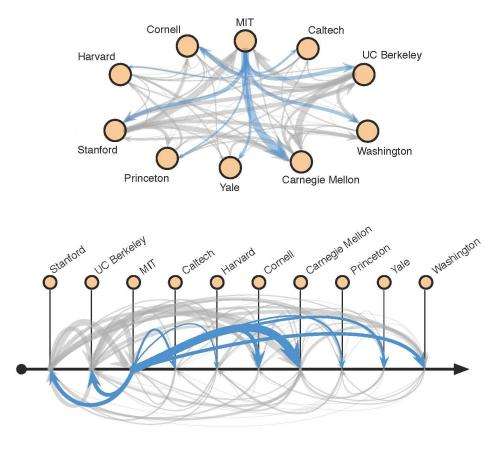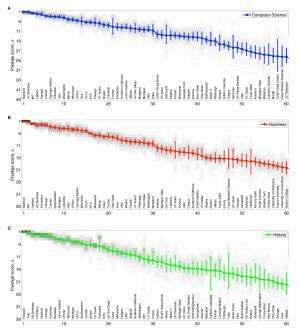It takes more than merit: Alma mater's prestige highly predictive of faculty placement

A new study finds that small differences in institutional prestige have an enormous impact on the likelihood that a person who graduates with a doctoral degree will land a coveted faculty job.
The advantage of alma mater prestige in finding a job is so great that it cannot be explained solely by a difference in educational quality between the universities, according to the study, led by the University of Colorado Boulder and published today in the journal Science Advances.
Instead, the findings indicate that the social status of universities plays an important role in the faculty hiring process among their alumni.
"We're not talking about a huge difference in quality between the top-10 institutions and the next 10," said Aaron Clauset, an assistant professor of computer science at CU-Boulder and lead author of the study. "And yet, in terms of the ability to place people in tenure-track faculty positions, it is a huge difference."
The study relied on hand-collected data about the educational histories of 19,000 current faculty members in three disciplines at hundreds of doctoral degree-granting institutions across the country.
Clauset and his colleagues found that only 25 percent of doctoral degree-granting institutions across the country produce 71 to 86 percent of tenure-track faculty, depending on the field.

The study also showed that the top 10 schools in each of the fields studied—computer science, business and history—produced between 1.6 and 3 times more faculty than the second tier of 10 schools and between 2.3 and 5.6 times more faculty than the third tier of 10 schools.
The research team found that, on average, women graduating from the same elite institution as men had a more difficult time obtaining sought-after faculty appointments than their male counterparts.
For the study, institutions were ranked based on the faculty hiring networks themselves. An institution's prestige was calculated from its ability to hire candidates from better ranked programs and its ability to place its graduates in desirable faculty positions elsewhere.
"We're looking at evaluations of the output of a program," Clauset said. "When a Ph.D. goes out on the job market, other institutions evaluate how well that person's institution did in training them. The more people hired as faculty, and at more prestigious places, the more the community is saying the institution is doing a good job. By focusing on faculty hiring decisions, we're basically leveraging the experts in the field to make these program evaluations."
This output-based system of ranking institutions differs from more traditional rankings, like those used by U.S. News & World Report, which have been criticized for heavily relying on educational "inputs," such as standardized test scores and the financial investment made per student.
The ranking system created by Clauset and his colleagues better predicted the placement of doctoral graduates than either the U.S. News & World Report rankings or the National Research Council rankings.
Clauset first became interested in the factors that influence faculty hiring decisions when he was a graduate student at the University of New Mexico. He and two other doctoral students looked into what data were available to answer the question, but found there were none and let the question drop.
"We wondered who actually got hired into faculty jobs," Clauset said. "I think this is a pretty common question for doctoral students, since getting a Ph.D. is a major life investment, and many of us aspired to become faculty and have our own research groups."
Clauset picked the question back up after getting hired at CU-Boulder in 2010. He hired graduate students to collect data on three disparate academic disciplines. In all, the data collection effort took thousands of hours over several years.
"In addition to satisfying my own curiosity about these questions, our findings of systemic biases and fundamental hierarchies in faculty hiring provide a more clear picture of how academia works," Clauset said. "And the network-based technique we developed for ranking doctoral programs, which is based on expert evaluations of educational outcomes, provides a nicely data-driven approach to comparing institutions."
"These findings may help individuals who are contemplating a faculty career, and I hope they encourage a frank discussion more generally on whether the system is operating the way we want it to."
More information: Systematic inequality and hierarchy in faculty hiring networks, Science Advances, DOI: 10.1126/sciadv.1400005
Provided by University of Colorado at Boulder


















